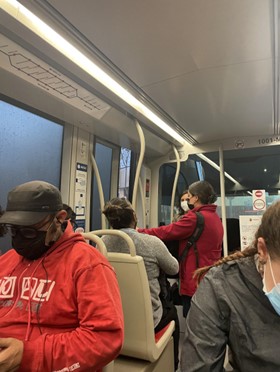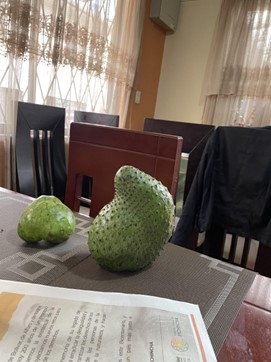Tell Us Something We Don’t Know
By Maxine
I recently got an email from my grandpa in the U.S., who liked to send me work games/fun facts on a regular basis. He asked me to “tell us [my grandparents] something we don’t know.” At first, I was stumped by this prompt. There’s too much to say! But I understood his broad query; he doesn’t have much to guide his questioning. When I call my parents, all I want is to hear about the mundane details of their life at home. What did they have for dinner? How’d they spend Sunday afternoon? What’s in season at the farmer’s market? I want to be taken into their life, in a small way. In the spirit of that desire and to answer my grandfather’s question, I’m going to use this space to write about some of the small, beautiful, and/or surprising facts of life in Cuenca.
The first thing to understand about Cuenca is that time moves more slowly here. It’s a growing city of 700,000 people that at times still considers itself a sleepy mountain town. There is a third rush hour at 1pm, when everyone (from students to businessmen) tries to make it home for lunch. If they’re not doing that, then they’ll be found sipping coffee, strolling in the streets, or passing time by the river(s). People work hard, but they take their breaks seriously. (Lunch is often two hours.)
As in the U.S., where we see Christmas decorations going up the day after Thanksgiving, people here love their holidays and aren’t afraid to celebrate early. It’s a very Catholic country, and I have already spotted Christmas trees in people’s houses. But also, I had a very fun dinner the other night of guaguas de pan and colada morada. This pairing is typical of Día de los Difuntos. The holiday is Nov. 2nd, and people here enjoy the most delicious parts as early as possible.

 Ok, topic change. But, PUBLIC TRANSPORTATION! It’s so much better than in Baltimore, and way more widely used. Busses crisscross most parts of the city (and some cover rural areas), and there’s also a long tram/tranvía route. Its big windows let in purple dusk light as I commute home in the evenings, which is one of my favorite parts of the day.
Ok, topic change. But, PUBLIC TRANSPORTATION! It’s so much better than in Baltimore, and way more widely used. Busses crisscross most parts of the city (and some cover rural areas), and there’s also a long tram/tranvía route. Its big windows let in purple dusk light as I commute home in the evenings, which is one of my favorite parts of the day.
 Food is such a big part of life here, being the primary element around which friends and family gather, as well as a way in which people show care towards each other. It was definitely a source of culture shock for me, so here are some things you should know. If you go a day without eating rice at least twice, then something may be wrong. And it breaks exactly zero rules to combine rice with noodles or potatoes. Most meals start with soup. You can drink yogurt. And the fruit! It’s amazing, obviously. Some new favorites of mine include the granadilla, chirimoya (looks like a dinosaur; tastes like bubblegum, but in a good way), and something that my family calls a durazno (peach) but is smaller and feels closer to an apricot…? Here, there are multiple types of pineapples, bananas, and avocados, which is new to me. I sometimes forget I’m so close to the equator, but the produce reminds me. Ok, other things. Instead of the free bread you sometimes get at restaurants in the U.S., here you get popcorn. It’s often eaten in soup. This does not mean, however, that Cuenca lacks in bread. There are probably a dozen panaderías per block, meaning I’ve yet to eat a single piece of sliced, bagged bread. This is less of a thing in my family, but fresh made juices are super common. I’ve tried juices made of tamarind, pineapple, coconut, naranjilla, and tomate de árbol, to name a few. I’ve yet to try guayaba juice, but I have had homemade guayaba marmalade.
Food is such a big part of life here, being the primary element around which friends and family gather, as well as a way in which people show care towards each other. It was definitely a source of culture shock for me, so here are some things you should know. If you go a day without eating rice at least twice, then something may be wrong. And it breaks exactly zero rules to combine rice with noodles or potatoes. Most meals start with soup. You can drink yogurt. And the fruit! It’s amazing, obviously. Some new favorites of mine include the granadilla, chirimoya (looks like a dinosaur; tastes like bubblegum, but in a good way), and something that my family calls a durazno (peach) but is smaller and feels closer to an apricot…? Here, there are multiple types of pineapples, bananas, and avocados, which is new to me. I sometimes forget I’m so close to the equator, but the produce reminds me. Ok, other things. Instead of the free bread you sometimes get at restaurants in the U.S., here you get popcorn. It’s often eaten in soup. This does not mean, however, that Cuenca lacks in bread. There are probably a dozen panaderías per block, meaning I’ve yet to eat a single piece of sliced, bagged bread. This is less of a thing in my family, but fresh made juices are super common. I’ve tried juices made of tamarind, pineapple, coconut, naranjilla, and tomate de árbol, to name a few. I’ve yet to try guayaba juice, but I have had homemade guayaba marmalade.



